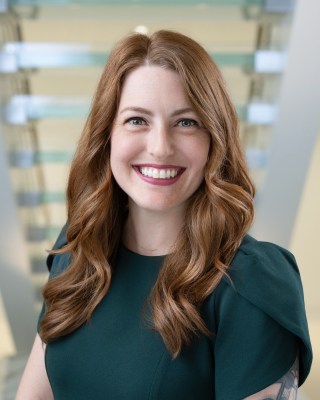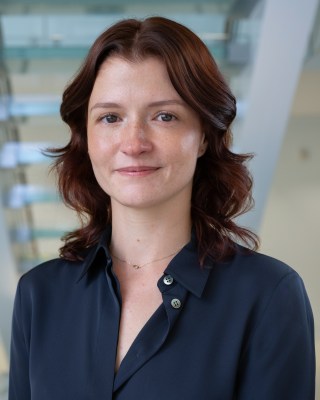
Religious switching into and out of Judaism is rare in Israel, the only country where Jews are a majority of the population. Fewer than 1% of Israelis who were raised Jewish say they belong to a different religion today, or to no religion at all, according to a 2024 Pew Research Center survey. This includes, for example, Israelis who were Jewish as children and have since become Christian, or those who grew up Jewish and are now unaffiliated (i.e., they identify religiously as atheist, agnostic or “nothing in particular”). And only about 1% of Israelis who identify as Jewish today were raised in a different religion or no religion at all.
But switching groups within Judaism is far more common. Some switch to a group that is more religiously observant – for example, someone who was raised “religious” (Dati in Hebrew) becoming “ultra-Orthodox” (Haredi). Others switch to a group that is less observant – for example, someone raised “traditional” (Masorti) who becomes “secular” (Hiloni) later in life.
Here are four key findings about religious switching within Judaism in Israel, drawn from the 2024 Center survey.
Terminology
What is ‘religious switching’?
Religious switching refers to a change between the religious group in which a person says they were raised (during their childhood) and their religious identity now (in adulthood). We use the term religious switching instead of “conversion” because the changes can take place in many directions – including switching to a group that is more secular or to a group that is more religious.
Jewish religious groups in Israel: Haredim, Datiim, Masortim and Hilonim
Nearly all Israeli Jews identify as Haredi (commonly translated as “ultra-Orthodox”), Dati (“religious”), Masorti (“traditional”) or Hiloni (“secular”). These groups represent a spectrum of religious observance in Israel, where Haredim are generally the most religious and Hilonim the least.
This spectrum of religious observance does not always line up perfectly with Israel’s political spectrum. For more information on these Jewish religious groups, read the Center’s 2016 deep dive on the topic “Israel’s Religiously Divided Society.” For a more recent look at differences in their political views, read our 2024 report “How Israeli Society Has Unified, and Divided, in Wartime.”
About one-fifth of Israeli Jews (22%) have switched from one Jewish group to another since childhood. Most of this switching comes from Jewish Israelis who were raised Masorti (10%) or Dati (9%).
Switching rates also differ by age. Jewish Israelis ages 50 and older are more likely than those under 35 to have switched religious groups (33% vs. 8%).
However, rates of switching within Judaism are similar among men and women, as well as between people with differing levels of education.
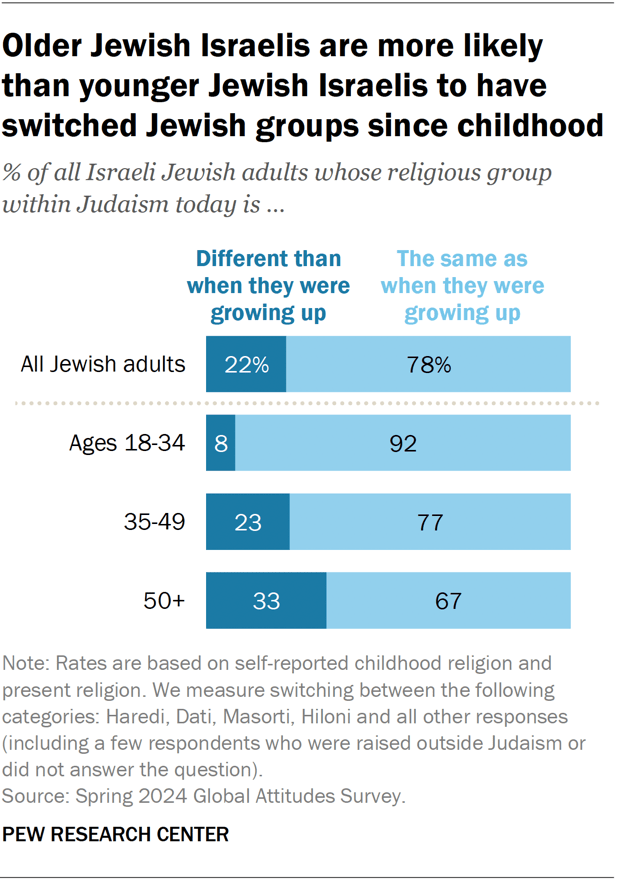
Hilonim have seen the largest overall growth through religious switching. Specifically, 9% of Israeli Jews say they have become Hiloni over the course of their lifetime after having been raised in another group (most commonly Masorti). In comparison, 3% of all Israeli Jewish adults say they were raised Hiloni and no longer identify as such.
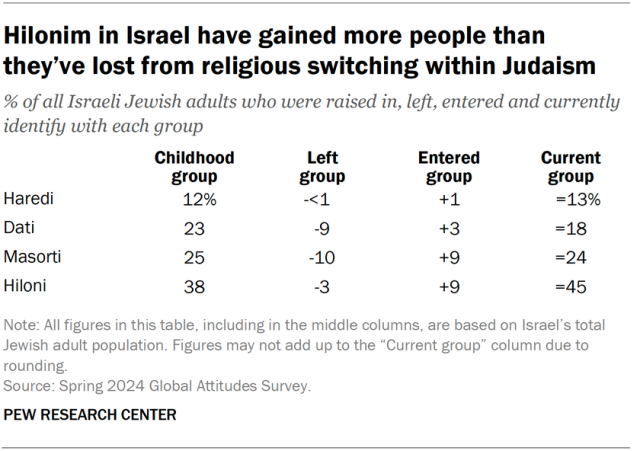
Datiim have seen the largest overall decline due to switching. Among all Israeli Jews, 9% say they were raised Dati but have since left the group. Only 3% were raised in a different group and are now Dati. A total of 7% of Israeli Jews were raised Dati and are now Masorti.
Similar shares of Israeli Jews have left (10%) and entered (9%) the Masorti group. Most Jews who were raised Masorti and left are now Hiloni, but a small share have become Dati. And most of those who have become Masorti were raised Dati.
Fewer than 1% of Israeli Jews were raised Haredi and have switched to a different group since childhood. A similarly small share was not raised Haredi but now identifies as such.
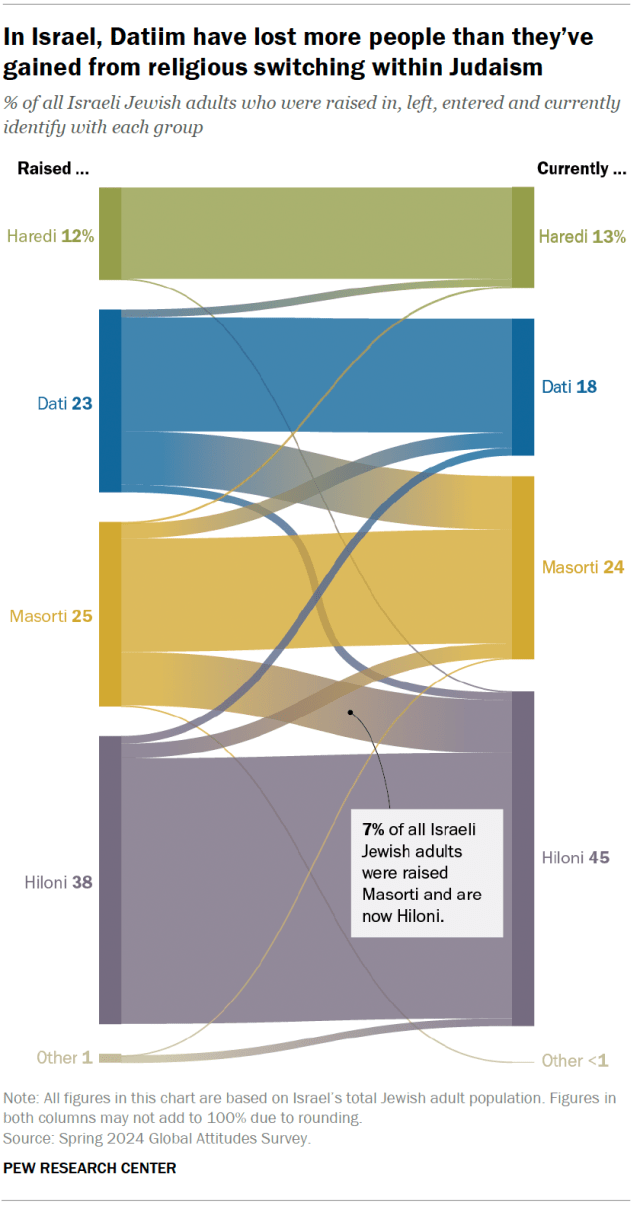
Hilonim have higher retention rates than Datiim and Masortim. Retention rates show, among all the people who say they were raised in a particular religious group, the percent who still describe themselves as belonging to that group today.
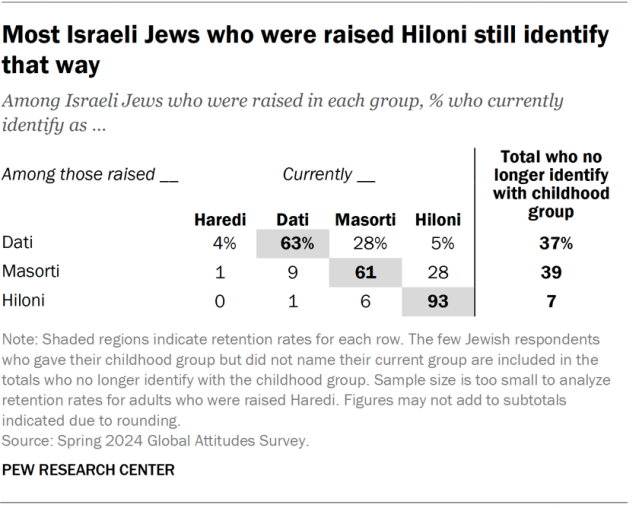
Most Israeli Jews who were raised Hiloni still identify as Hiloni today (93%). Conversely, only about six-in-ten Jewish Israelis who were raised Dati or Masorti have retained that identity.
(Our survey did not have enough Israeli Jews who were raised Haredi to analyze retention rates for them separately.)
More Israeli Jews have switched to a less observant group (15%) than to a more observant one (6%).

“More observant” includes:
- Those raised Hiloni who are now Masorti, Dati or Haredi
- Those raised Masorti who now identify as Dati or Haredi
- Those raised Dati who are currently Haredi
“Less observant” includes:
- Those raised Haredi who have become Dati, Masorti or Hiloni
- Those raised Dati who are now Masorti or Hiloni
- Those raised Masorti who currently identify as Hiloni
Datiim and Masortim are especially likely to have switched to a group that is considered less observant. For instance, 8% of Israeli Jews were raised Dati but are now either Masorti or Hiloni. Only 1% of Israeli Jews were raised Dati and have become Haredi, a group that is generally more observant.
Similarly, 7% of Israeli Jews were raised Masorti and are now secular, while 3% are more observant, identifying as either Dati or Haredi.
Only 3% of Jewish Israelis were raised Hiloni (generally the least observant group) and have become more observant in adulthood. And fewer than 1% were Haredi (the most observant of the groups) and have become less observant over their lifetime.
For more on religious switching in 36 countries, read our report “Around the World, Many Are Leaving Their Childhood Religions.”
Around 80% of the world’s Jewish population lives in Israel and the United States. For more on religious switching within Judaism in the U.S., read “Denominational switching among U.S. Jews: Reform Judaism has gained, Conservative Judaism has lost.”
Note: Here are the questions and responses used for this analysis, along with the survey methodology.
